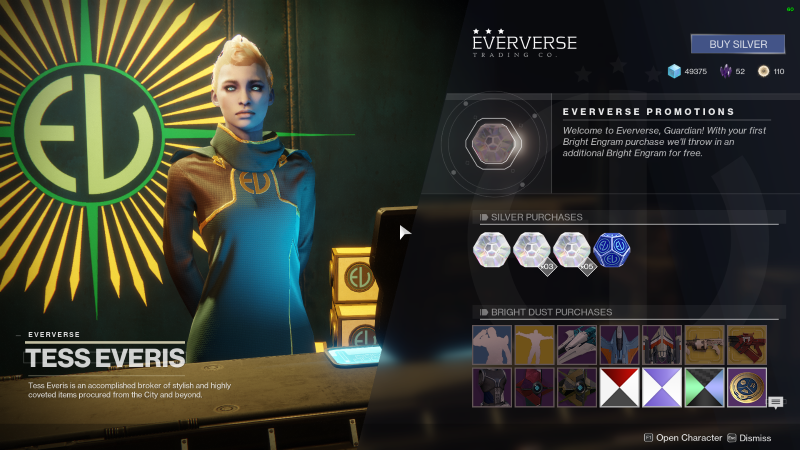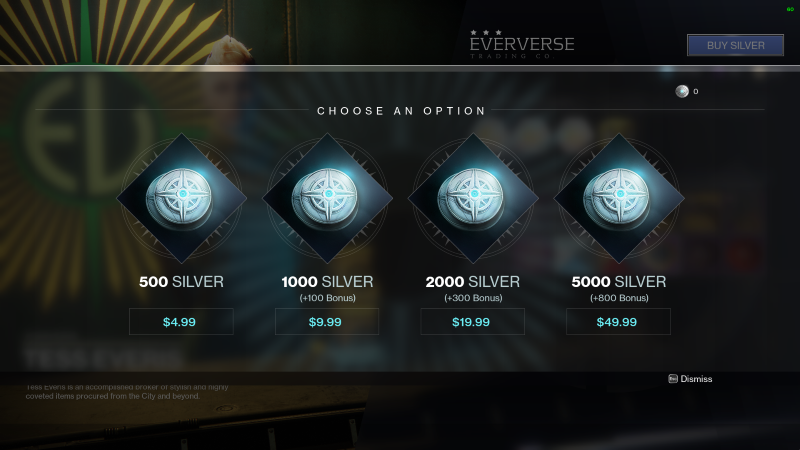In Destiny 2 there is a shop that sells in-game items for real money.1 In that shop there is a vendor. Her name is Tess. Tess knows a thing or two about psychology. Well, three things at least.
Like most big games with an online focus, Destiny 2 lets players buy cosmetic items with “silver” which is an in-game currency that can be exchanged for real world money. This is a nice little revenue stream for Activision Tess, so like any effective salesperson she’ll a few tricks to get you to buy some silver and spend it.

Your friendly Eververse representative is here to help. Isn’t that nice?
One of the first things I noticed is how Tess invokes the norm of reciprocity. At a few points in the campaign an icon is placed at Tess’s store, telling the player that he or she has something to gain by talking to the NPC. Indeed, Tess has a free bright engram gift for you, which can be opened (decoded, whatever) to reveal some sweet cosmetic items! Tess even tells you something along the lines of how she appreciates your heroic efforts and wants you to succeed against Earth’s enemies. And according to the psychological principle of reciprocity, you may feel a little obligated to pay back the favor by doing a little shopping.
The reciprocity effect is put to use by marketers and savvy businesspeople all the time. For years the March of Dimes charity sent me a lovely set of return address labels for use with my Christmas cards. The labels were a free gift, but not coincidentally, they came in the same envelope as a plea to donate. The message is clear: “Dude, we totally just gave you some free stuff. You should return the favor with a donation.” Psychologist Robert Cialdini explained in a 2001 article in Scientific American how the Disabled American Veterans organization used this same trick to increase the success rate of their appeals for donations from 18% to 35%.2
The second psychological sales trick that Tess Everis seems to know is that you probably spend silver more freely than real money. A long line of consumer psychology research has shown that we spend more when we are using store credit, which is basically what Destiny 2’s Silver is. Back in 1998, Drazen Prelec and George Lowenstein published an important paper where they proposed a thoeory about how people experience the displeasure of paying for something.3 Paying money for something causes displeasure or pain. If our expected pleasure from the purchase outweighs the pain, then no problem. But if it doesn’t, then we’re less likely to make the purchase. One way that retailers have figured out to reduce the perceived pain of a purchase is to disconnect thoughts about the payment from thoughts about the purchase.

Okay, I’ll give you some credit here, Tess. So to speak.
Using in-game credit like Silver places a temporal buffer between the pleasure of the thing bought and the pain of the purchase. The pain has already taken place so when the time comes to spend the credit you bought, you don’t experience it and thus are more likely to spend more. Research shows that we tend to think of it as a separate transaction that causes less mental displeasure and perceptions of cost. (If you want more on this topic, I have an entire chapter in my book.)
The third psychological trick that Tess seems to know is is related to something called “transparency” Consumer psychologists have also long known that another way to reduce the pain of purchases is to make it more difficult for you to think about exactly how much you’re playing. That is, to make the transaction less transparent. Cash is highly transparent in that you know exactly how much of it you’re giving up in the transaction. Checks and credit are less transparent because we don’t tend to think as much about the money they represent and we’re likely to spend more.4
But things like Destiny 2’s silver are the least transparent at all. Figuring out how much Silver translates to in real money involves math that most of us won’t bother with. How much did those 500 Silver you just bought? Well, you paid $5 for 500 Silver, there’s 100 cents to the dollar, so …wait. This math isn’t very hard at all. It’s basically one cent per silver.
Y’all. Tess done screwed up on this one. Guess she doesn’t know all the tricks after all. Either that or she’s showing a bit of restraint. Let’s hope for the latter and give Activision a thumbs up for this one.



I’m sure you realize it, but engrams are also a currency. It’s $->silver->engram->[loot]. Tess’s free engram is little different than a social/mobile F2P game tutorial or new-user-experience showing you how to spend premium currency by gifting you some that must be used immediately.
afaik, Destiny 2 may allow you to accept her engram and walk away without converting it, but the engram is just a simple scratch-off lotto ticket or a slot machine spin… …
The silver math isn’t difficult in US dollars, but for other currencies it is. For example, 2000 silver (plus you get a 300 bonus, so essentially 2300 silver) in GBP is £16.79, in AU$ is $29.95, and in CAD is $26.99. This is all taken from the Microsoft Store, where the USD prices (at least) are the same as the in-game prices.
Maybe for Tess’ sanity she just needed to maintain a 1:1 exchange rate *somewhere* on Earth…
Further to the above, maybe also the 300 bonus serves to skew judgement when the exchange would otherwise be 1:1? So in USD 2300 silver for $20 is more confusing.
Ah, that’s a good point.